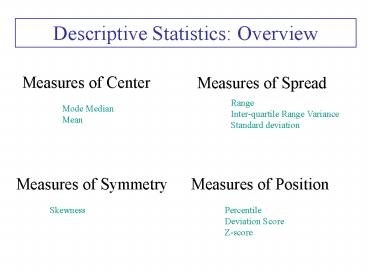Descriptive Statistics: Overview - PowerPoint PPT Presentation
1 / 24
Title:
Descriptive Statistics: Overview
Description:
Author: Jasia Pietrzak Created Date: 07/07/2003 13:33:01 Title: Center & spread Central tendency & variability Last modified by: Garth Scott Company – PowerPoint PPT presentation
Number of Views:67
Avg rating:3.0/5.0
Title: Descriptive Statistics: Overview
1
Descriptive Statistics Overview
2
Central tendency
- Seeks to provide a single value that best
represents a distribution
3
Central tendency
4
Central tendency
5
Central tendency
6
Central tendency
- Seeks to provide a single value that best
represents a distribution - Typical measures are
- mode
- median
- mean
7
Mode
- the most frequently occurring score value
- corresponds to the highest point on the frequency
distribution
8
Mode
- The mode is not sensitive to extreme scores.
9
Mode
- a distribution may have more than one mode
10
Mode
- there may be no unique mode, as in the case of a
rectangular distribution
11
Median
- the score value that cuts the distribution in
half (the middle score) - 50th percentile
For N 15 the median is the eighth score 37
12
Median
For N 16 the median is the average of the
eighth and ninth scores 37.5
13
Mean
- this is what people usually have in mind when
they say average - the sum of the scores divided by the number of
scores
Changing the value of a single score may not
affect the mode or median, but it will affect the
mean.
14
Mean
__
In many cases the mean is the preferred measure
of central tendency, both as a description of the
data and as an estimate of the parameter.
X7.07
15
Mean
The mean is sensitive to extreme scores and is
appropriate for more symmetrical distributions.
16
Symmetry
- a symmetrical distribution exhibits no skewness
- in a symmetrical distribution the Mean Median
Mode
17
Skewed distributions
- Skewness refers to the asymmetry of the
distribution
- A positively skewed distribution is asymmetrical
and points in the positive direction.
Mode 70,000 Median 88,700 Mean 93,600
- mode lt median lt mean
18
Skewed distributions
- A negatively skewed distribution
- mode gt median gt mean
19
Measures of central tendency
-
Mode quick easy to compute useful for nominal data poor sampling stability
Median not affected by extreme scores somewhat poor sampling stability
Mean sampling stability related to variance inappropriate for discrete data affected by skewed distributions
20
Distributions
- Center mode, median, mean
- Shape symmetrical, skewed
- Spread
21
Measures of Spread
- the dispersion of scores from the center
- a distribution of scores is highly variable if
the scores differ wildly from one another - Three statistics to measure variability
- range
- interquartile range
- variance
22
Range
- largest score minus the smallest score
- these two
- have same range (80)
- but spreads look different
- says nothing about how scores vary around the
center - greatly affected by extreme scores (defined by
them)
23
Interquartile range
- the distance between the 25th percentile and the
75th percentile - Q3-Q1 70 - 30 40
- Q3-Q1 52.5 - 47.5 5
- effectively ignores the top and bottom quarters,
so extreme scores are not influential - dismisses 50 of the distribution
24
Homework
- Page 275 1, 2, 3, 6 - 8







![[PDF] Statistics in Plain English [Print Replica] Kindle Edition Free PowerPoint PPT Presentation](https://s3.amazonaws.com/images.powershow.com/10100160.th0.jpg?_=20240816063)























